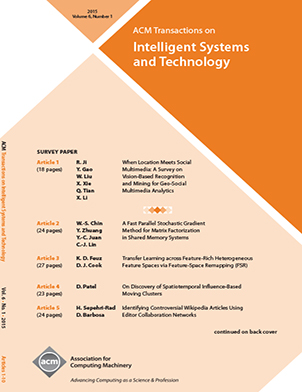设计:为支持协同学习的人工智能物联网进行在线设备选择和边缘关联
IF 7.2
4区 计算机科学
Q1 COMPUTER SCIENCE, ARTIFICIAL INTELLIGENCE
引用次数: 0
摘要
人工智能物联网(AIoT)是一项新兴技术,能让众多 AIoT 设备参与大数据分析和机器学习(ML)模型训练,为工业制造提供各种定制化智能服务。联邦学习(FL)使 AIoT 应用能够在不共享原始数据的情况下进行保护隐私的分布式模型训练。然而,由于物联网设备的计算和内存资源有限,现有的用于人工智能物联网应用的联合学习方法无法支持高效的大规模模型训练。联合协同学习(FSyL)是一种很有前景的协作范式,它通过将部分 ML 模型卸载到边缘服务器来进行端到端协作训练,从而减轻了资源受限的 AIoT 设备的计算和通信开销。现有的 FSyL 作品既不能有效解决轮间设备选择问题以提高模型多样性,也不能确定轮内边缘关联以降低训练成本,这阻碍了支持 FSyL 的 AIoT 的应用。受这一问题的启发,本文首先研究了在 AIoT 中执行 FSyL 的瓶颈。它建立了一个联合轮间设备选择和轮内边缘关联的优化模型,以平衡模型多样性和训练成本。为了解决难以解决的耦合问题,我们提出了一个名为 "成本-多样性权衡的在线设备选择和边缘关联 FSyL(DESIGN)"的框架。首先,我们从原始问题中提取了边缘关联子问题,并通过博弈论确定了任意设备选择的最优关联决策。然后,根据最优关联决策,将设备选择建模为组合多臂匪徒(CMAB)问题。最后,我们提出了一种在线机制,以获得设备选择和边缘关联的联合决策。我们对 DESIGN 的性能进行了理论分析,并在实际数据集上进行了实验评估。结果表明,与最先进的技术相比,DESIGN可以节省高达84.3%的成本,并提高23.6%的准确率。本文章由计算机程序翻译,如有差异,请以英文原文为准。
DESIGN: Online Device Selection and Edge Association for Federated Synergy Learning-enabled AIoT
The Artificial Intelligence of Things (AIoT) is an emerging technology that enables numerous AIoT devices to participate in big data analytics and machine learning (ML) model training, providing various customized intelligent services for industry manufacturing. Federated Learning (FL) empowers AIoT applications with privacy-preserving distributed model training without sharing raw data. However, due to IoT devices’ limited computing and memory resources, existing FL approaches for AIoT applications cannot support efficient large-scale model training. Federated synergy learning (FSyL) is a promising collaborative paradigm that alleviates the computation and communication overhead on resource-constrained AIoT devices via offloading part of the ML model to the edge server for end-to-edge collaborative training. Existing FSyL works neither efficiently address the inter-round device selection to improve model diversity nor determine the intra-round edge association to reduce the training cost, which hinders the applications of FSyL-enable AIoT. Motivated by this issue, this paper first investigates the bottlenecks of executing FSyL in AIoT. It builds an optimization model of joint inter-round device selection and intra-round edge association for balancing model diversity and training cost. To tackle the intractable coupling problem, we present a framework named Online DEvice SelectIon and EdGe AssociatioN for Cost-Diversity Trade-offs FSyL (DESIGN). First, the edge association subproblem is extracted from the original problem, and game theory determines the optimal association decision for an arbitrary device selection. Then, based on the optimal association decision, device selection is modeled as a combinatorial multi-armed bandit (CMAB) problem. Finally, we propose an online mechanism to obtain joint device selection and edge association decisions. The performance of DESIGN is theoretically analyzed and experimentally evaluated on real-world datasets. The results show that DESIGN can achieve up to \(84.3\%\) in cost-saving with an accuracy improvement of \(23.6\%\) compared with the state-of-the-art.
求助全文
通过发布文献求助,成功后即可免费获取论文全文。
去求助
来源期刊

ACM Transactions on Intelligent Systems and Technology
COMPUTER SCIENCE, ARTIFICIAL INTELLIGENCE-COMPUTER SCIENCE, INFORMATION SYSTEMS
CiteScore
9.30
自引率
2.00%
发文量
131
期刊介绍:
ACM Transactions on Intelligent Systems and Technology is a scholarly journal that publishes the highest quality papers on intelligent systems, applicable algorithms and technology with a multi-disciplinary perspective. An intelligent system is one that uses artificial intelligence (AI) techniques to offer important services (e.g., as a component of a larger system) to allow integrated systems to perceive, reason, learn, and act intelligently in the real world.
ACM TIST is published quarterly (six issues a year). Each issue has 8-11 regular papers, with around 20 published journal pages or 10,000 words per paper. Additional references, proofs, graphs or detailed experiment results can be submitted as a separate appendix, while excessively lengthy papers will be rejected automatically. Authors can include online-only appendices for additional content of their published papers and are encouraged to share their code and/or data with other readers.
 求助内容:
求助内容: 应助结果提醒方式:
应助结果提醒方式:


